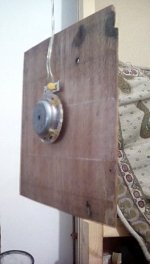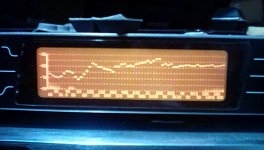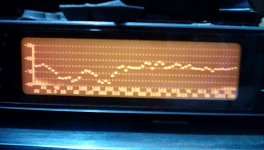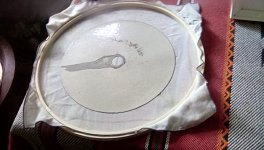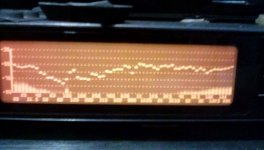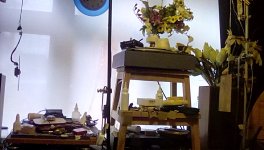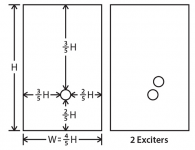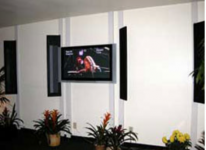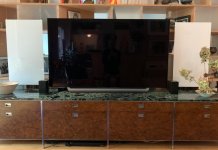Well if there is no card in Brazil , that's out.
Of course there's card, but not the one you used. There must be similar product in office shops, papershops. Maybe the brown material used in cardboard boxes?
The cardboard must have some stiffness to keep its flat shape, even before painting with pvc, right?
The simpler card you surely can get in papershops is called here cartolina, and comes in different colors. I think is mosly used in schools. I think it's thinner and less stiff than that on cereal (or similar) boxes. Gluing several sheets together, perhaps 5 or 6, might provide the necessary stiffness.
There's a type of cardboard, I now remember, that might work. It's used for painting. You paint it with PVC to seal it and be able to use it for oil painting. Perhaps that's the material of choice. It's not sold in papershops, but in art shops. It should be painted on both sides for the DMLs, I think. Cutting the sheet in two and gluing them might do it.
It sounds like you are talking about what I know as hardboard.
the soft rough surface is probably going to cause you problems.
So both surfaces have to be smooth. Then the option should be 3mm plywood then.
carlmart.
in the past ive used cut up pizza boxes ,it really does not matter ,as long as it is about .5mm .
a 1mm panel with pva is just right for what is needed not too stiff and not too heavy.
although i am wondering what a layer of epoxy on the card might sound like?
i just thought that if you XO the panels at 300hz,it would be a lot easier , cheaper and should sound better than the canvas panel, in my opinion ,that is.
dont get me wrong ,the canvas panel is a good fullrange panel,but is not needed if 300hz is the xo point.
a ten inch or smaller card panel should work fine down to your 300hz point.
think of it as an almost full range flat paper cone driver, but it is a dml.
steve.
in the past ive used cut up pizza boxes ,it really does not matter ,as long as it is about .5mm .
a 1mm panel with pva is just right for what is needed not too stiff and not too heavy.
although i am wondering what a layer of epoxy on the card might sound like?
i just thought that if you XO the panels at 300hz,it would be a lot easier , cheaper and should sound better than the canvas panel, in my opinion ,that is.
dont get me wrong ,the canvas panel is a good fullrange panel,but is not needed if 300hz is the xo point.
a ten inch or smaller card panel should work fine down to your 300hz point.
think of it as an almost full range flat paper cone driver, but it is a dml.
steve.
300Hz is fine with me.
It seems that most people that got good results with DMLs used a sub from 300Hz down.
As long as the 300-20KHz is reasonably flat, adding a bandpass sub should make matters less critical in the low frequencies.
It seems that most people that got good results with DMLs used a sub from 300Hz down.
As long as the 300-20KHz is reasonably flat, adding a bandpass sub should make matters less critical in the low frequencies.
Carlmart.
I'm back to poor quality photos again as my note 4 has died ,I believe it is a power chip problem ?
Anyway.
The first picture is of the 7inch 2mm wood panel I found in my shed .
The wood bends one way but not the other because of the wood grain.
Nothing done to it except glued the exciter to the panel with pva.
Pic 2 is the microphone at 30cm with pink noise.
Pic 3 is at 1m, as requested by some.
Pic 4 is at 3m.
There are some peaks at about 1.5k ,that is probably something to do with the coil cavity area.
This panel can happily xo at 300hz.
And sounds remarkably good,with plenty of headroom.
Japanese drums handled well at realistic levels in my room.
Steve.
I'm back to poor quality photos again as my note 4 has died ,I believe it is a power chip problem ?
Anyway.
The first picture is of the 7inch 2mm wood panel I found in my shed .
The wood bends one way but not the other because of the wood grain.
Nothing done to it except glued the exciter to the panel with pva.
Pic 2 is the microphone at 30cm with pink noise.
Pic 3 is at 1m, as requested by some.
Pic 4 is at 3m.
There are some peaks at about 1.5k ,that is probably something to do with the coil cavity area.
This panel can happily xo at 300hz.
And sounds remarkably good,with plenty of headroom.
Japanese drums handled well at realistic levels in my room.
Steve.
Attachments
You didn't give much attention to the paint paper cards sold in art houses, which are about 40" x 30", about 1mm thick if I recall, and can be split in two and glued together to maker stiffer boards.
They can be painted with pvc on both sides, and should hold a pvc glued resonator, I think.
Have you tried them or think they might be worth a shot?
Why yes or why not?
They can be painted with pvc on both sides, and should hold a pvc glued resonator, I think.
Have you tried them or think they might be worth a shot?
Why yes or why not?
Both things, card panel or plywood I would have buy anyway.
Nothing at home I might give a try with.
Nothing at home I might give a try with.
Talking of pizzas .
Yesterday I applied some epoxy to an old card and fabric hoop panel I had not got around to throwing away yet.
I just want to see what it sounds like ,when I get around to attaching an exciter ,that is.
Steve.
Yesterday I applied some epoxy to an old card and fabric hoop panel I had not got around to throwing away yet.
I just want to see what it sounds like ,when I get around to attaching an exciter ,that is.
Steve.
Attachments
I think paper would be a problem ,as it would probably wrinkle.
I would think it would have to be card and only in small sizes ,maybe 12inches max ?
You are free to experiment with what ever you can get your hands on.
Amazon do 2mm balsa ply pretty cheaply, about 12inches or So ?
I'm now wishing I had not sent mine back, as I only wanted balsa, not ply.
Steve.
I would think it would have to be card and only in small sizes ,maybe 12inches max ?
You are free to experiment with what ever you can get your hands on.
Amazon do 2mm balsa ply pretty cheaply, about 12inches or So ?
I'm now wishing I had not sent mine back, as I only wanted balsa, not ply.
Steve.
Carlmart.
You will not be able to mount an exciter to a 1mm card panel, it will bend.
You need to mount the card panel to the rigidly mounted exciter.
The panel should be free floating, and only attached by the central coil mounting.
steve
You will not be able to mount an exciter to a 1mm card panel, it will bend.
You need to mount the card panel to the rigidly mounted exciter.
The panel should be free floating, and only attached by the central coil mounting.
steve
I took a couple of pictures of my two small panels facing each other, and the response 3m into the room.
Sorry again about the picture quality, but as you can see the response from the side plot, that is still very good from 300hz to over 20k.
In case anyone was in any doubt that dml is omnidirectional.
Steve.
Sorry again about the picture quality, but as you can see the response from the side plot, that is still very good from 300hz to over 20k.
In case anyone was in any doubt that dml is omnidirectional.
Steve.
Attachments
Dual Center Channel DML solution for home theater
Magnepan dual center channel
Sony BRAVIA LED Acoustic Surface
See: Inside the acoustic surface powering Sony's first OLED TV/
Also see attached snap shot from the Sony site.
It appears that Sony has mounted exciters on the OLED screen itself to deliver left - center - right channels from a single panel.
A Sony | Magnepan mashup...
Questions
This idea may live on the fringes of possibility, but it seems like something the physics DMLs can/should support.
Thoughts appreciated.
-- Andreas
I've gathered materials for a specific DML application experiment.
I've written a bit about this on another thread, but thought this thread could provide some guidance.
I've begun assembling a pair of DMLs to flank a 65" TV (see attached photo).
I currently have one Dayton Audio Thruster mounted (at a 2/5 location) on each of two 1/16" thick pieces of plexiglass I had left over from a home project.
I haven't finished the panels (e.g., sanded the edges or rounded the corners) or done any measurements yet, but they actually sound very promising as left and right stereo channels.
A center channel presents some challenges. I don't have a good place to locate a center channel either above or below the TV monitor.
I've written a bit about this on another thread, but thought this thread could provide some guidance.
I've begun assembling a pair of DMLs to flank a 65" TV (see attached photo).
I currently have one Dayton Audio Thruster mounted (at a 2/5 location) on each of two 1/16" thick pieces of plexiglass I had left over from a home project.
I haven't finished the panels (e.g., sanded the edges or rounded the corners) or done any measurements yet, but they actually sound very promising as left and right stereo channels.
A center channel presents some challenges. I don't have a good place to locate a center channel either above or below the TV monitor.
Magnepan dual center channel
Magnepan has developed the idea of a dual-center channel solution, which suggests a solution (see attached photo referred to in the following from Magnepan's website):
In the photo of my TV and DML panels you can see a pair of small conventional speakers I used to test out the concept. To my ears, this seems very promising.
While I can simply make a second pair of DMLs to serve as the "dual center channel", I think that DMLs may give a more interesting solution.
No place for a center channel speaker?
The photo below is of a demonstration in a hotel during a Consumer Electronic Show in Las Vegas. The on-wall models immediately flanking the on-wall video monitor provide a dual center channel array which can outperform a single center channel speaker.
A pair of our on-wall speakers achieves a center channel image in the same manner as a stereo system achieves a center image. By angling the speakers approximately 30 degrees to the wall, the center channel speaker on the left of the video monitor is on-axis with the viewer off to the right--- and consequently is louder than the center channel speaker on the right of the monitor (which is closer to the viewer). This "pulls" the audio image to the left and keeps the dialog centered on the screen better than point source speakers.
And there is a bonus for those willing to install this unorthodox concept. In blind-fold testing, listeners found that center channel dialog and information was easier to understand with a "Maggie" dual center than with a conventional single center channel speaker. Extensive research on speech intelligibility is available on the internet.
In the photo of my TV and DML panels you can see a pair of small conventional speakers I used to test out the concept. To my ears, this seems very promising.
While I can simply make a second pair of DMLs to serve as the "dual center channel", I think that DMLs may give a more interesting solution.
Sony BRAVIA LED Acoustic Surface
Sony has designed the surface of the BRAVIA OLED to double as a sound source. The picture is the sound. This innovative audio setup, called Acoustic Surface, uses four actuators affixed to the back of the panel to turn the entire screen into a sound-emitting structure.
See: Inside the acoustic surface powering Sony's first OLED TV/
Also see attached snap shot from the Sony site.
It appears that Sony has mounted exciters on the OLED screen itself to deliver left - center - right channels from a single panel.
A Sony | Magnepan mashup...
While I haven't reached the experimental stage where I'd try sticking Thrusters on the back of my TV, the Sony solution leads me to my latest experiment.
I have a second pair of Thrusters, which I intend to attach to the current DMLs and send them the center channel information.
If this works, it should replicate the Magnepan dual center channel concept.
I have a second pair of Thrusters, which I intend to attach to the current DMLs and send them the center channel information.
If this works, it should replicate the Magnepan dual center channel concept.
Questions
Given the placement of my current exciters (2/5 position), where should I consider mounting the center channel exciters?
Should I follow the Dayton Audio advice on placing a second exciter near the first (see first attached photo) or would some other 2/5 related placement make more sense?
Should I follow the Dayton Audio advice on placing a second exciter near the first (see first attached photo) or would some other 2/5 related placement make more sense?
This idea may live on the fringes of possibility, but it seems like something the physics DMLs can/should support.
Thoughts appreciated.
-- Andreas
Attachments
Last edited:
Steve,
r:
That introduces some intriguing placement possibilities that would go a long way to my (architect) wife, accepting my experiments.
Thanks.
-- Andreas
r:
In case anyone was in any doubt that dml is omnidirectional.
That introduces some intriguing placement possibilities that would go a long way to my (architect) wife, accepting my experiments.
Thanks.
-- Andreas
aagas,
Have you considered a conventional sound bar? However, if it works, the 2nd set of exciters mounted on your current DMLs would be more aesthetically pleasing, and be a whole lot cheaper.
Have you considered a conventional sound bar? However, if it works, the 2nd set of exciters mounted on your current DMLs would be more aesthetically pleasing, and be a whole lot cheaper.
aagas.
To be honest , I don't think having two totally different channels on separate exciters running on the same panel is a good idear.
The exciters will be fighting each other for control of the panel.
You could easily test this using temporary double sided tape and a little exciter support.
Magnepans are well known for beaming and tries to act as a piston.
Although dml is very good at keeping a central image when you move from the left to the right side of the stereo image, you are not crossing between two beams , they are very omnidirectional.
I had to have a bit of a think about this, but I don't think any of my ideas will go down well with your other half 😀
your panels look quite large what frequency are you xo the panels at ?
Your surround panels are basically in the position of the centre channel according to magnepan.
The only thing I could think of that might please you and your architect , is maybe cutting the panel in half and using the lower half as the centre channel and the top half as the surround ?
It might be a way the way round this problem ?
I'm presuming you can't have the surrounds further out to the left and right ?
Steve.
To be honest , I don't think having two totally different channels on separate exciters running on the same panel is a good idear.
The exciters will be fighting each other for control of the panel.
You could easily test this using temporary double sided tape and a little exciter support.
Magnepans are well known for beaming and tries to act as a piston.
Although dml is very good at keeping a central image when you move from the left to the right side of the stereo image, you are not crossing between two beams , they are very omnidirectional.
I had to have a bit of a think about this, but I don't think any of my ideas will go down well with your other half 😀
your panels look quite large what frequency are you xo the panels at ?
Your surround panels are basically in the position of the centre channel according to magnepan.
The only thing I could think of that might please you and your architect , is maybe cutting the panel in half and using the lower half as the centre channel and the top half as the surround ?
It might be a way the way round this problem ?
I'm presuming you can't have the surrounds further out to the left and right ?
Steve.
Steve,
Panels: 32.7" h x 18" w
I'll get the DMLs configured properly, measure them, then think about xo to a subwoofer if I think I need it (and I can hide it somewhere out of sight).
All of this just for TV viewing. I use my much larger aluminum DMLs for my main audio listening.
I've had the same idea. Easy enough to do, but I've thought to do it only if my original idea doesn't work out.
For now, suspending judgment, any thoughts about where to position the second set of exciters?
-- Andreas
your panels look quite large what frequency are you xo the panels at ?
Panels: 32.7" h x 18" w
I'll get the DMLs configured properly, measure them, then think about xo to a subwoofer if I think I need it (and I can hide it somewhere out of sight).
All of this just for TV viewing. I use my much larger aluminum DMLs for my main audio listening.
The only thing I could think of that might please you and your architect , is maybe cutting the panel in half and using the lower half as the centre channel and the top half as the surround ?
I've had the same idea. Easy enough to do, but I've thought to do it only if my original idea doesn't work out.
I'm presuming you can't have the surrounds further out to the left and right ?
For now, suspending judgment, any thoughts about where to position the second set of exciters?
-- Andreas
Last edited:
I managed to glue the damaged exciter to the epoxy card hoop panel ��
So I've had to remove it again.
I have now marked it as bad ,so it shouldn't happen again.
But before I did this I took some measurements at 1ft .
The response looks pretty good with a useful output down to about 30hz near field.
Would make a very decent near field monitor or computer speaker.
I had no complaints about the sound of the epoxy so I will be putting on a decent exciter for more testing as the main set of speakers.
Even if I still had my phone recorder I wouldn't have recorded the panel as the buzzing was pretty bad.
Steve
So I've had to remove it again.
I have now marked it as bad ,so it shouldn't happen again.
But before I did this I took some measurements at 1ft .
The response looks pretty good with a useful output down to about 30hz near field.
Would make a very decent near field monitor or computer speaker.
I had no complaints about the sound of the epoxy so I will be putting on a decent exciter for more testing as the main set of speakers.
Even if I still had my phone recorder I wouldn't have recorded the panel as the buzzing was pretty bad.
Steve
Attachments
Last edited:
Steve, one of the applications for my DMLs I will be judging is for good quality near field computer speakers. Compared to the good quality 2-way Vifa speakers I use now, which should be replace with 2-way SB units.
So the comparison should be to good speakers. But I am curious about the audio being handled by just one device, which would be the DML.
So the comparison should be to good speakers. But I am curious about the audio being handled by just one device, which would be the DML.
Carlmart.
I'm still waiting for the glue to dry, but hopefully can do some near field tests.
My experience with dml up close is very similar to wearing headphones, this will be more so with the full range canvas and my hoop panel, I hope ?
I did notice that when I was using the hoop full range with my transmission line speakers they were helping under pin the low end at about 30hz , this was when I was sitting in my seat at 3m !!
Computer speakers usually need a sub, these panels go lower than most subs especially near field as you are not trying to drive the room.
You are basically in the full range power zone of the panel , very similar to headphones.
The microphones I use to do my recordings ,would not pic this up as they roll off sharply at 50hz and at about 10k.
Steve.
I'm still waiting for the glue to dry, but hopefully can do some near field tests.
My experience with dml up close is very similar to wearing headphones, this will be more so with the full range canvas and my hoop panel, I hope ?
I did notice that when I was using the hoop full range with my transmission line speakers they were helping under pin the low end at about 30hz , this was when I was sitting in my seat at 3m !!
Computer speakers usually need a sub, these panels go lower than most subs especially near field as you are not trying to drive the room.
You are basically in the full range power zone of the panel , very similar to headphones.
The microphones I use to do my recordings ,would not pic this up as they roll off sharply at 50hz and at about 10k.
Steve.
Last edited:
Even normal speakers do need a sub, and I was planning to install a bandpass sub under the desk, using one or two 6.5" Madisound speakers I bought some time ago and didn't use.
So the same should be valid for the DMLs, if necessary.
Canvas boards should be better for that?
What did you apply the glue waiting to dry to?
Carlos
So the same should be valid for the DMLs, if necessary.
Canvas boards should be better for that?
What did you apply the glue waiting to dry to?
Carlos
- Home
- Loudspeakers
- Full Range
- A Study of DMLs as a Full Range Speaker
